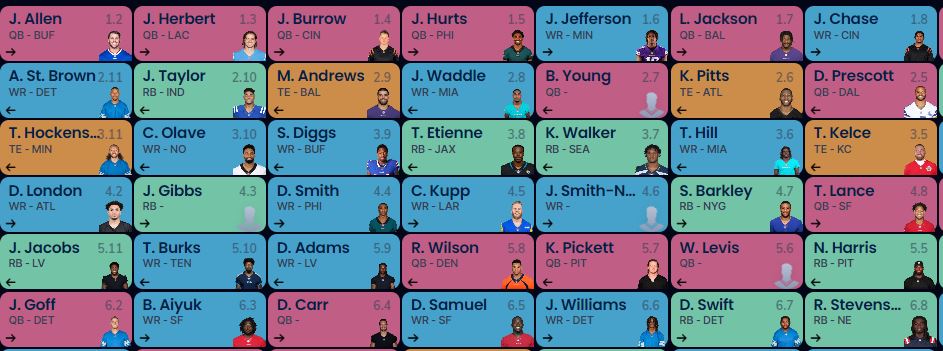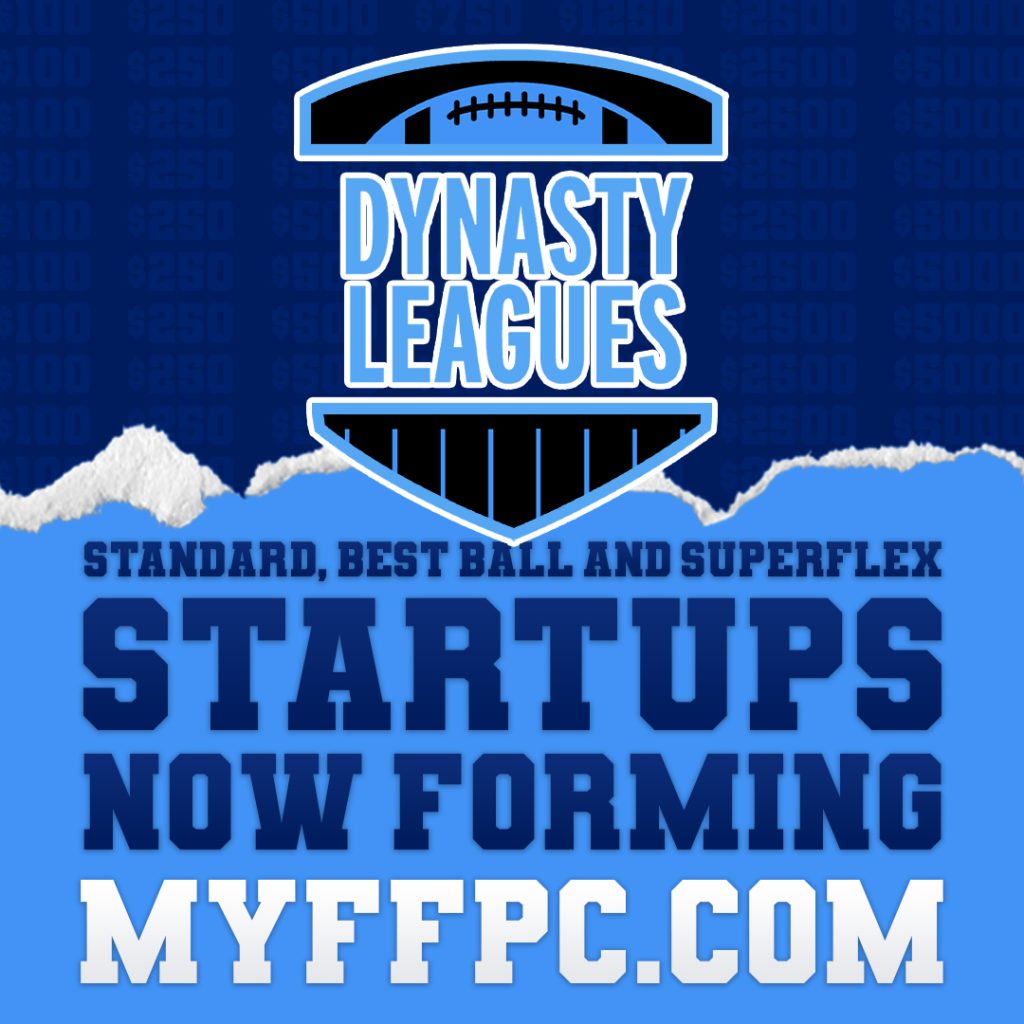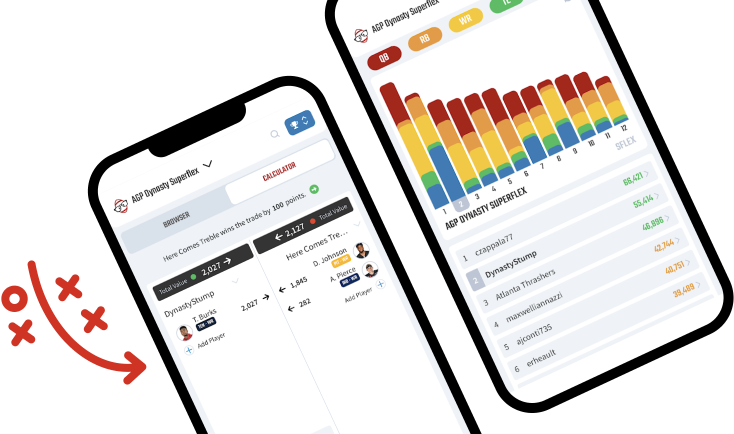We’re in peak startup season, which means there are several strategies for getting optimal results. I’ve started several businesses in my lifetime and, as a result, have a few theories and strategies that I love to use. In this article, I’ll discuss eight strategies, each with positives and negatives. Generally, I am a value-based drafter and use the board to guide my startup strategy.
Trading Down Constantly
I frequently use this strategy and am a fan of trading down early and often, especially if I’m drafting later in the first round. If you’re not getting the best of the best (e.g., Josh Allen, Patrick Mahomes) in a Superflex league, there isn’t a huge urgency in my mind to rush and make a pick. This is especially true in start 1QB leagues, where there could be a high variance among rankings and positional players.
The simple strategy here is to let the board fall to you and trade down to the bottom of the tier of players you have a tier. This allows you additional draft picks and movement during the draft, allowing you to stay within the tiers regarding the quality of talent your team is acquiring.
The value of trading down during the draft is often desired and hard to execute. Suppose you’re going to use this strategy. In that case, the best way to deploy it is by sending out offers to every person in the league when you’re on the clock or soon to be on the clock. This lets them know you’re interested in moving the pick and what the cost is. This will allow you to negotiate and get a deal done. Don’t be scared of how long this will take, as this time of year is a slow draft season, and this will be your team for hopefully 5+ years. Sculpt it how you want, and don’t let the groaning of drafting fast get in the way of your strategy.
Win Now Mode
This strategy is for those who want to push all their chips in and win a championship year one above all else. The thought here is that, as owners worry about the age drop-off of players in certain tiers, their value continues to drop. Travis Kelce is a perfect example, as several owners were worried he was getting too old and may not continue to be a high-end producer.
This movement hinges on drafting a team with proven players who will continue to score points in the coming fantasy season. If you used this strategy last season, you wouldn’t care if Tom Brady retired in 2023 because you felt you were getting a top-12 quarterback in 2022 at a discount.
This strategy is lucrative but can lead many owners into bad spots regarding challenging rebuilds as soon as the first year if the players you were relying upon don’t pan out. The NFL changes fast, and if you’re going to go all in year one, then I advise being a seasoned dynasty veteran with the ability to adjust on the fly and rebuild teams. You never know when the wheels will fall off on this type of build.
The Youth Movement

This is essentially the opposite of the Win-now team. It is equally as dangerous as the All-in team, as you’re going from investing in proven high-end talent to going all-in on proven young talent. Both have inherent risks, including the possibility of the youth picks flaming out of the league within a couple of years.
Last year, some people let DeAndre Hopkins drop to the 10th round of startup drafts in place of taking the youth prospects of Elijah Moore based on a limited sample size. There is discretion when deploying this strategy, but by and large, you should stay away from running backs playing on the final year of their rookie deal or older and any wide receiver above the age of 27. You should draft early players such as Justin Jefferson, Ja’Marr Chase, and CeeDee Lamb, but you wouldn’t dare touch Davante Adams, etc.
After about Round 3, you start to get murky in terms of the talent gap if you’re operating under an age-based figure here. When you avoid proven talent, you hope the youth you’re drafting can reach the production you’re avoiding. If you went this route last year and took Dallas Goedert instead of Darren Waller, it would be a good use of the trajectory of the players’ careers.
You need to pile up and make the correct picks of youthful players who are due to make a major step up in production. If these players don’t take the step up, you could also quickly find yourself entering a rebuild. For example, if you drafted Jalen Reagor early in a startup in his rookie year, you’d find yourself trying to find young players to step up into fantasy superstardom.
The ZeroRB Approach
This approach has gained plenty of traction over the years as the running back position has not been a poster child of health or consistency in recent times. In fact, every consensus first overall running back has been injured and missed several games over the last three seasons. When injuries happen to a position built on such scarcity, it makes their backups even more valuable.
This is essentially the argument that has made the strategy so popular. However, if you want to consistently contend for the title in your league, building your team around a running back won’t get you there. Over the last 3-5 years, the consensus running backs that you have to pay up for year in and year out have not lived up to expectations. Todd Gurley left the league during year three of his dominance, Saquon just returned to where he was after two abysmal years, and Jonathon Taylor and Christian McCaffrey are other examples. When using the ZeroRB approach, you deploy other strategies to build positional dominance around positions with much less volatility and are more predictable regarding their health and longevity.
You should go for a quarterback early in a Superflex league, or you can opt for a superstar receiver or tight end. Regardless, the goal is to build your team around other positions that have much less volatility in terms of career arcs.
Robust RB
This is counter to the 0RB method and involves drafting several different running backs. Essentially, the drafter will select nothing but running backs for their starters and flex spots before any other position. There is value to this method if you can get the three best running backs on the board in your draft due to the wide acceptance of the 0RB strategy in recent years. However, I often associate this strategy with a win-now mindset, as the running back position is highly volatile and changes quite frequently.
As we stand here now, Bijan Robinson is the RB1, and Jonathon Taylor (who was largely the RB1 last year) is going in the second round of drafts. If you can draft multiple high-end running backs with this strategy, you’re also banking on them finishing the season, which has been incredibly hard to see in recent years. If a running back plays in 14 of 17 games in a season, this is considered a successful season in terms of health at the position.
QB Early (Robust QB)
When I first entered the Superflex realm of dynasty, I thought I could use the late-round quarterback approach that had found me success in the redraft world of fantasy football. However, in recent years, I have learned the error of my ways and often advise others to go quarterback early if they can land one. In current drafts, if I’m drafting late, I love to go for Dak Prescott and/or Deshaun Watson. This allows you to have two high-end producers at the highest scoring position, with little uncertainty in terms of their NFL future.
This strategy hinges on drafting the position with your first and second pick of a Superflex draft if you can get cornerstones at the position. I’m open to getting an older veteran later in the draft before you’ve filled your entire starting roster too! As we approach the off-season quarterback carousel, several quarterbacks are finding themselves wondering where Derek Carr, Jimmy Garoppolo, Aaron Rodgers, and even Trey Lance could be playing. Drafting franchise quarterbacks early and often is the best setup for success in dynasty. Instead of drafting a quarterback every year, where you’re essentially the Washington Commanders of fantasy football. This is the highest-scoring position, and not having a five-year plan for the position makes it very hard to be in the championship discussion every season.
Late Round QB
This is essentially the opposite of the previous approach. If you’re going to draft the quarterback position later than the rest, then you’re taking on much more risk. You’ll rely upon drafting a Jared Goff later in the draft and hope he can keep his competition at bay or even become the future franchise signal caller. However, if you took Carson Wentz in the tenth round of startups last year and relied upon him as a starter, things can take a turn for the worst.
The best way to win using this strategy is to draft rookie signal-callers who aren’t as big a name as their fellow rookies. This would mean drafting Justin Herbert in his rookie season before ever playing a snap in the NFL. He wasn’t going Round 1 of a startup like Trevor Lawrence. If you’re drafting veterans late, using this approach, then it is murky and could end up wrong more often than not. If you do go this route this off-season, I’d suggest going for Jordan Love as a late-round target.
Bully Tight End

The final strategy I have embraced is the Tight End Premium strategy, or bully tight end. Over time, I have come to appreciate the benefits of having a reliable fantasy asset at the tight end position. In terms of fantasy, only 3-5 tight ends make a significant difference, and having one of these players can significantly enhance your team.
The strategy is to try and secure 2-3 difference-making tight ends early in the draft. That will give you a positional advantage over your opponents. For example, if you had Travis Kelce, Dallas Goedert, and Mark Andrews (or George Kittle) on your team last year, you would have had a significant advantage over your opponents in one starting slot each week. These small point advantages at the tight end position every week can help make your team a consistent contender and can help you win close games later in the season.
However, this strategy involves the risk of losing top-end talent at other positions during the startup. Still, with careful drafting during rookie drafts, it could be a highly successful strategy in the long run, especially if you can pair the right quarterbacks with your tight ends in a Superflex/Tight End Premium league.









